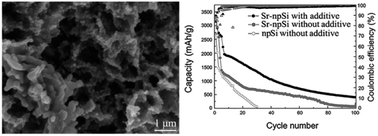A porous silicon anode prepared by dealloying a Sr-modified Al–Si eutectic alloy for lithium ion batteries
Abstract
Silicon has been considered to be one of the most promising anode materials for next generation lithium ion batteries due to its high theoretical specific capacity. However, its huge volume expansion during the lithiation/delithiation process that can result in rapid capacity fading and low conductivity present significant challenges for application. In this study, the morphology of Si in an Al–Si eutectic alloy was modified by Sr, and porous Si was then produced by dealloying the precursor. Profiting from the unique structure, the Si anode exhibits an excellent reversible capacity of 405 mA h g−1 at 0.5 A g−1 after 100 cycles and a fantastic first cycle coulombic efficiency of 83.74%. Furthermore, the porous silicon modified by Sr delivers a stable capacity of 594.8 mA h g−1 even at a high current density of 2 A g−1 after 50 cycles, suggesting a good rate capability.



 Please wait while we load your content...
Please wait while we load your content...